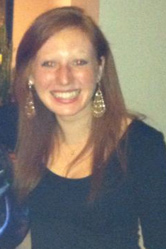Ancient Studies and Anthropology major
“From Dracula to Ditches: Exploration of Roman Mithraism in Dacia”
Faculty Mentor: Tim Phin

Roman MarkerI participated in the Apulum Mithraeum III Project in Alba Iulia, Romania, an archaeological excavation of a Roman temple dedicated to the god, Mithras. Mithraism was known for its mysterious practices in the Roman Empire. Beginning in the first century AD and continuing into the fifth century AD, it was comprised entirely of men, typically in the military. It arrived in Dacia by the third century AD, when Rome conquered the region, establishing a new capital and settlements. My research for this project included a review of current scholarly literature on Mithraism and visiting the National Museum of Alba Iulia where many local Mithraic artifacts are kept. I noted types of artifacts in Mithraeums specific to Alba Iulia; further, I learned a great deal about Roman Mithraism through archaeological excavation. Records of Mithraic practices were rarely written down, thus the archaeological excavation was crucial to my research because most of what scholars know about Mithraism is derived from archaeological excavations. Through this excavation, we were able to confirm that this structure was a Mithraeum and I was able to apply my background research to understanding and interpreting our artifacts as well as planning for further excavation for summer 2014.

What research experiences have you had?
I participated in the Apulum Mithraeum III Project in Romania, summer 2013, as a supervisor assistant working with students to develop archaeological excavation techniques (i.e. single-context recording, natural strata differentiation, section/plan drawing, etc.). Through this project I was able to research Mithraism through current literature and archaeological excavation. In the summer of 2012, I interned with the Lost Towns Project in Edgewater, MD learning archaeological techniques in the field at both Colonial and Native American sites, and processing the artifacts in a lab afterwards.
Who did you work with on this project?
I was the only student from UMBC, the American students that came with us were from Princeton University, where one of the directors is a professor, and the Romanian students were mostly from Babes-Boylei University in Cluj, Romania where director, Dr. Mariana Egris, teaches.
Do you get course credit for this work? Paid? How much time do you put into it?
The excavation itself was completely funded by Princeton University and I also received an Ancient Studies Department Summer Scholarship of $2500.00 to travel to Romania and conduct my research through this archaeological project. I was not paid to be in Romania and I spent four weeks there.
What academic background did you have before you started?
My Ancient Studies major prepared me for the archaeological aspect of this excavation through courses such as Latin, Archaeological Method and Theory, and the Archaeological Field Experience Internship. I have also taken a class on Roman history, however, I had never read about Roman cultic religions until a year ago and so I have done independent research on the topic so that I could apply it to the archaeological project and even the other Roman sites that we visited in Romania, such as the Roman capital and gold mines.

What was the hardest part about your research?
The most challenging part about this research was creating my own reading list and preparing for the archaeological excavation. I plan to have a future career in archaeology and so the field work was the easy part for me, it was the reviewing and reading beforehand that was difficult because there would be times that I would not be sure if I was reading the best sources or understanding the core concepts of what I should be learning and how to connect it to the archaeology. Once I arrived in Romania and I ventured through the capital, Bucharest, I saw a great deal of Roman presence through archaeological artifacts in the Bucharest Museum and this was a pivotal moment for me when my readings and preparation fused with the Roman archaeology and it proved crucial for my own Mithraeum project.
3/11/2014